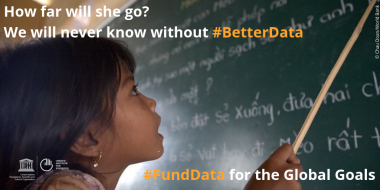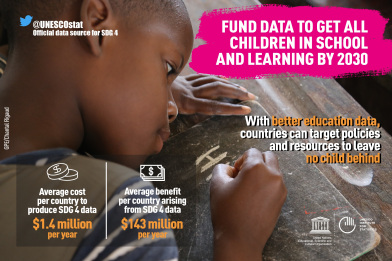38 organizations issue a collective call to fund education data that will allow the world to reach Sustainable Development Goal 4
Back in February, the UNESCO Institute for Statistics (UIS) and its partners sent out an urgent call to make the case for education data. Now we have an opportunity to make that case – loudly and clearly – directly to policy-makers.
Hundreds of international, regional and national policymakers will be in New York from 9 to 18 July to discuss global progress in education during the UN High-Level Political Forum on Sustainable Development (HLPF). It’s an opportunity we cannot afford to miss. That’s why we are issuing a collective call for greater funding for data on Sustainable Development Goal 4 (SDG 4): a quality, inclusive education for all. Our message is clear: we need more and better data not only to monitor progress towards that goal but also to achieve it.
Data for action and results
It is true that significant strides have been made since 2000, with more children in school than ever before and a narrowing of the gender gap in primary education in particular. But many challenges persist, with 262 million children and adolescents – one in every five – out of school. That figure rises to a shocking one in three children excluded from education in the world’s poorest countries.
Then there are the challenges related to learning and education quality. An estimated 617 million children and adolescents worldwide are not reaching minimum proficiency levels in reading and mathematics. While one-third of them are out of school, two-thirds are sitting in the world’s classrooms, waiting for an education that delivers. Such alarming statistics demonstrate that data can serve as a wake-up call for action.
The urgent need to support countries
Policymakers need more precise and timely data to know which children, youth and adults are making progress and which are not, and why. Yet today, education planners in many countries are working in the dark, without the data they need to target policies and resources. Many national statistical offices still struggle to report data on the basics – from the numbers of girls who never set foot in a classroom to the number of schools with clean drinking water.

To track progress towards SDG 4, policymakers also need a broader span of education data, from expenditure on education to teacher training. They need data on new and more complex indicators, particularly those related to learning, skills and equity. This means looking beyond basic indices to capture more disaggregated data on the compounding and cumulative impacts of poverty, gender, disability, conflict as well as on learning outcomes.
There is a growing recognition of the need for better data for better policies, which is why countries have agreed to an SDG 4 monitoring framework that includes 43 global and thematic indicators. Yet today, fewer than half of countries report data on flagship indicators, such as learning outcomes in primary and secondary education.
A strong investment case
The UIS has calculated the costs of continuing to do business as usual against the costs of making the necessary investment in education data. The results are conclusive: it would cost on average about US$1.4 million per year per country to produce all of the SDG 4 indicators (or an overall global investment of $280 million per year). This is a small price to pay when set against the vast benefits of providing a quality education for all and the unacceptable costs of lost prospects for current and future generations.

Studies have shown that inefficiency levels in education systems can be as high as 30%, with, for example, many students repeating grades or leaving school early – a dreadful waste of resources. The benefits of having data to identify under-performing schools and children at risk are self-evident and confirmed by even the most conservative scenario.
Better data would lead to a minimum 10% gain in efficiency on average in most countries. So, in return for an annual investment of US$1.4 million on education data, a country save an average of US$143 million a year in the running costs of its education system. Imagine having an additional US$143 million – on average – to spend on teachers, better classroom conditions and reaching marginalized children. To put it simply, investing millions today will save billions in the future.
A message from countries for the HLPF: More funding please
During recent regional meetings to prepare for this year’s HLPF, countries sent a strong message: more funding please. Delegates from the Asia-Pacific region reported that “greater investment was needed in national statistical systems that were struggling to meet the demand for more and better data for the Global Goals and targets” (ESCAP Regional Report). Countries in sub-Saharan Africa stressed the need for a “significant investment in data technologies, capacity, infrastructure, and human and financial resources” and called for a “solidarity fund for statistical development” (ECA Regional Report).
Data are a necessity – not a luxury – for all countries. With greater support, low-income countries could conduct surveys to track the educational pathways – and barriers – facing each individual in a household. They could see whether children with disabilities, for example, are in school or out. They could evaluate the skills of youth and adults to better target their policies and programs. Donors and development partners could leverage their investments, while civil society groups and communities could use the same information to help ensure that everybody – child, youth or adult – can have a quality education.
This is why we have joined the UIS to take one message to policymakers and the international community: make 2019 the year that we fund data so that no one is left behind.
Centre de Recherche pour la Gestion de la Biodiversité (CRGB)
Coalition Nationale pour l’ Education Pour Tous, Sénégal
Education and Academia Major Group
Global Education Monitoring Report
Global partnership for sustainable development data
Innovations for Poverty Action
The International Commission on Financing Global Education Opportunity
International Council for Adult Education (ICAE)
International Council of Sport Science and Physical Education
Inter-agency Network for Education in Emergencies (INEE)
Madagascar Initiatives for Digital Innovation (MAIDI)
Millennium@EDU SUSTAINABLE EDUCATION Foundation
Réseau Mauritanien Education pour tous RMEPT /ADPDH
Sustainable Development Solutions Network (TReNDS & SDG Academy)
UNESCO Institute for Statistics
WorldPop, University of Southhampton
If you believe in the power of data, join us in supporting this call:
- share this blog
- Join @UNESCOstat to endorse the call to #FundData


Having data to guide and help prepare relevant and proper policy on education is long overdue.
Time to take relevant steps and action to remedy this.
LikeLike
Pingback: We Need More and Better Data on Education | Data for Sustainable Development | Millennium@EDU SUSTAINABLE EDUCATION